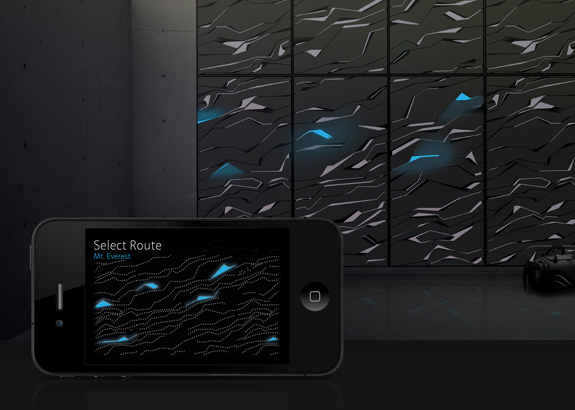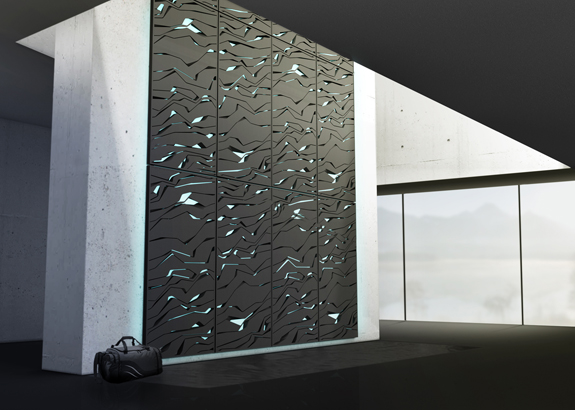New Tech May Have Athletes Climbing the Walls
How the Nova, the latest in artificial climbing wall design, goes from in-home gym to living room gallery
/https://tf-cmsv2-smithsonianmag-media.s3.amazonaws.com/filer/20120731122019LunarEU-Nova-Hold-alt2-tmb.jpg)
This climbing wall doubles as a piece of art work when not in use. Image courtesy of LUNAR Europe.
Walking into an indoor rock climbing gym can be overwhelming: Climbers dangle from the ceiling like an army of Spiderman clones, leaving a cloud of chalk in their wake. And as they scramble up walls speckled in colored, polyurethane holds that mimic the rock formations found in nature, good luck finding a route that’s open after 6 p.m. on a weeknight.
Earlier this summer, LUNAR Europe, a Munich-based design studio, thought it came up with a solution to the crowded-gym doldrums: Why not bring the climbing wall to your living room and make it pretty? The new in-home climbing system, the Nova, functions as a bouldering wall and doubles as an ambient piece of art when not in use. This dual-use concept is intriguing, but the product’s practicality remains in question.
The pattern-cut-outs, which replace the colored holds usually found on training walls at the gym, have built-in sensors that are synced with an iPhone app that can record and analyze climbing sessions. Select the level of difficulty (ranging from “Mt. Everest” to “Mt. Kilimanjaro”) and the app lights up the route and then rates your performance based on speed. All of this sounds pretty awesome when you consider what trekking up some of the world’s tallest mountains would be like, but the rating system doesn’t match up well with official climbing standards. Regular routes are rated on a scale ranging from 5.5 to 5.15d, explained in this conversion chart. Not surprisingly, grades like “Mt. Everest” do not translate.

An iPhone app lights up the route chosen by level of difficulty—”Mt. Everest” included, apparently. Image courtesy of LUNAR Europe.
Aesthetics aren’t everything—some climbers have their doubts. Those looking for a challenge require dynamic movement, horizontal overhangs, finger-crimping holds and…chalk. Not even a super-sleek design like the Nova can hide from the inevitable white cloud of dust a climber leaves behind.
It is also safe to say that the traditional climbing clientele wouldn’t be too concerned if their wall didn’t fit well with the “surrounding decor.” Pioneers like Patagonia founder, Yvon Chouinard, for example, certainly wouldn’t be impressed by a little ambient lighting. Chouinard said in a Q&A with Smithsonian.com in April, that gyms simply don’t replicate the real spirit of rock climbing, that “Climbing without risk isn’t climbing.” With new gadgets like the Nova hitting the market, “risk” may be a relative term.
The Abridged History of the Climbing Wall
The history of climbing is extensive enough to fill a few books. But, per the debate over the Nova, the most important innovation was the advent of the first artificial climbing wall, which was installed in 1964 by Don Robinson, a lecturer in the physical education department at Leeds University. And let’s just say his design wouldn’t meet modern indoor gym safety standards. The holds were made of real rocks—as though he chipped them off of a mountain himself—that were glued into a hallway at the university. By the ’70,s University of Washington, Evergreen State College and Hampshire College followed suit with a few bare-bones slabs of their own. It wasn’t until 1987 that the first commercial climbing gym in America, Vertical World in Seattle, came to fruition.
Materials have evolved significantly since 1987—from concrete, fiberglass, wood and steel—though the most common type of artificial climbing wall is a composite. Usually it will consist of a textured surface that gives it more of a “real rock” feel that overlies a plywood frame that is attached to weight and force-bearing steel frame. The Nova and a few other new concepts for climbers have made quite a departure from the traditional wall. These artificial climbing contraptions, for example:
Perhaps More Practical Applications of Climbing Technology
- Using the Rotor dynamic wall from Climblock is what climbing on a hamster wheel would feel like. It makes use of an automated rotating drum instead of the usual vertical wall, measuring in at 16.4 feet high, which makes sense for vertically challenged climbing facilities. For someone’s living room? Not so much.
- The ClimbStation, a Finnish innovation by Joyride Games, is a no-rope no-harness personal rock-climbing simulator that looks mostly terrifying. Some selling points: It allows for warm-up climbing and users can measure strength, choose from 12 levels of difficulty and monitor results with an accompanying touch screen. Though the “endless” wall only reaches a safe height and “does not require a specific supervisor” according to its website, a qualifier for those afraid of falling from any distance might be in order. Oh, and it costs $44,000. That too.
- If climbing “the rope” in gym class was a scarring event during your prepubescent years, do not go near Mt. Everclimb. The 12-foot high, continuous rope-climbing machine uses a pulley wheel and looped rope attached to its steel frame to create a never-ending climb. Though it sounds more like the parable of Sisyphus than an in-home gym, the basic model will set you back $4,500. If you’d like the coin operated version, it’ll cost you another two grand.
There’s no word from LUNAR as to whether the Nova will be sold commercially just yet. My guess though, is that the design might not be as cool as it’s chalked up to be.
/https://tf-cmsv2-smithsonianmag-media.s3.amazonaws.com/accounts/headshot/561436_10152738164035607_251004960_n.jpg)

/https://tf-cmsv2-smithsonianmag-media.s3.amazonaws.com/accounts/headshot/561436_10152738164035607_251004960_n.jpg)